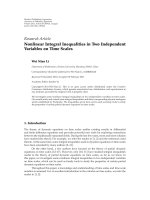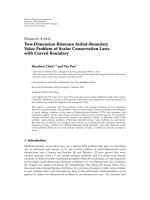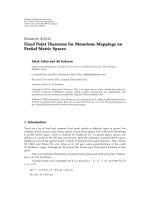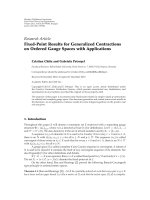Báo cáo hóa học: " Research Article Two Sharp Inequalities for Power Mean, Geometric Mean, and Harmonic Mean" pptx
Bạn đang xem bản rút gọn của tài liệu. Xem và tải ngay bản đầy đủ của tài liệu tại đây (461.28 KB, 6 trang )
Hindawi Publishing Corporation
Journal of Inequalities and Applications
Volume 2009, Article ID 741923, 6 pages
doi:10.1155/2009/741923
Research Article
Two Sharp Inequalities for Power Mean,
Geometric Mean, and Harmonic Mean
Yu-Ming Chu
1
and Wei-Feng Xia
2
1
Department of Mathematics, Huzhou Teachers College, Huzhou 313000, China
2
School of Teacher Education, Huzhou Teachers College, Huzhou 313000, China
Correspondence should be addressed to Yu-Ming Chu,
Received 23 July 2009; Accepted 30 October 2009
Recommended by Wing-Sum Cheung
For p ∈ R, the power mean of order p of two positive numbers a and b is defined by
M
p
a, ba
p
b
p
/2
1/p
,p
/
0, and M
p
a, b
ab, p 0. In this paper, we establish two
sharp inequalities as follows: 2/3Ga, b1/3Ha, b
M
−1/3
a, b and 1/3Ga, b
2/3Ha, b
M
−2/3
a, b for all a, b > 0. Here Ga, b
√
ab and Ha, b2ab/a b denote
the geometric mean and harmonic mean of a and b, respectively.
Copyright q 2009 Y M. Chu and W F. Xia. This is an open access article distributed under the
Creative Commons Attribution License, which permits unrestricted use, distribution, and
reproduction in any medium, provided the original work is properly cited.
1. Introduction
For p ∈ R, the power mean of order p of two positive numbers a and b is defined by
M
p
a, b
⎧
⎪
⎪
⎨
⎪
⎪
⎩
a
p
b
p
2
1/p
,p
/
0,
√
ab, p 0.
1.1
Recently, the power mean has been the subject of intensive research. In particular,
many remarkable inequalities for M
p
a, b can be found in literature 1–12. It is well known
that M
p
a, b is continuous and increasing with respect to p ∈ R for fixed a and b.Ifwe
denote by Aa, ba b/2,Ga, b
√
ab, and Ha, b2ab/a b the arithmetic mean,
geometric mean and harmonic mean of a and b, respectively, then
min
{
a, b
}
H
a, b
M
−1
a, b
G
a, b
M
0
a, b
A
a, b
M
1
a, b
max
{
a, b
}
.
1.2
2 Journal of Inequalities and Applications
In 13, Alzer and Janous established the following sharp double-inequality see also
14, page 350:
M
log 2/ log 3
a, b
2
3
A
a, b
1
3
G
a, b
M
2/3
a, b
1.3
for all a, b > 0.
In 15, Mao proved
M
1/3
a, b
1
3
A
a, b
2
3
G
a, b
M
1/2
a, b
1.4
for all a, b > 0, and M
1/3
a, b is the best possible lower power mean bound for the sum
1/3Aa, b2/3Ga, b.
The purpose of this paper is to answer the questions: what are the greatest values p and
q, and the least values r and s, such that M
p
a, b 2/3Ga, b1/3Ha, b M
r
a, b
and M
q
a, b 1/3Ga, b2/3Ha, b M
s
a, b for all a, b > 0?
2. Main Results
Theorem 2.1. 2/3Ga, b1/3Ha, b M
−1/3
a, b for all a, b > 0, equality holds if and
only if a b, and M
−1/3
a, b is the best possible lower power mean bound for the sum 2/3Ga, b
1/3Ha, b.
Proof. If a b, then we clearly see that 2/3Ga, b1/3Ha, bM
−1/3
a, ba.
If a
/
b and a/b t
6
, then simple computation leads to
2
3
G
a, b
1
3
H
a, b
− M
−1/3
a, b
b
2t
3
3
2t
6
3
1 t
6
−
8t
6
1 t
2
3
2bt
3
3
1 t
2
3
t
4
− t
2
1
×
t
2
1
3
t
4
− t
2
1
t
3
t
2
1
2
− 12t
3
t
4
− t
2
1
2bt
3
3
1 t
2
3
t
4
− t
2
1
×
t
10
2t
8
− 11t
7
t
6
14t
5
t
4
− 11t
3
2t
2
1
2bt
3
t − 1
4
3
1 t
2
3
t
4
− t
2
1
×
t
6
4t
5
12t
4
17t
3
12t
2
4t 1
> 0.
2.1
Next, we prove that M
−1/3
a, b is the best possible lower power mean bound for the
sum 2/3Ga, b1/3Ha, b.
Journal of Inequalities and Applications 3
For any 0 <ε<
1
3
and 0 <x<1, one has
M
−1/3ε
1 x
2
, 1
1/3−ε
−
2
3
G
1 x
2
, 1
1
3
H
1 x
2
, 1
1/3−ε
1
1 x
−2/32ε
2
−1
−
2
3
1 x
2
1 x
2
3
x
2
2x 2
1/3−ε
2
1 x
2/3−2ε
1
1 x
2/3−2ε
−
1 2x 4/3x
2
x
3
/3
1 x x
2
/2
1/3−ε
f
x
1
1 x
2/3−2ε
1 x x
2
/2
1/3−ε
,
2.2
where fx21 x
2/3−2ε
1 x x
2
/2
1/3−ε
− 1 1 x
2/3 −2ε
1 2x 4/3x
2
x
3
/3
1/3−ε
.
Let x → 0, then the Taylor expansion leads to
f
x
2
1
2 − 6ε
3
x −
1 − 3ε
1 6ε
9
x
2
o
x
2
×
1
1 − 3ε
3
x
1 − 3ε
2
18
x
2
o
x
2
− 2
1
1 − 3ε
3
x −
1 − 3ε
1 6ε
18
x
2
o
x
2
×
1
2 − 6ε
3
x −
2ε
1 − 3ε
3
x
2
o
x
2
2
1
1 − 3ε
x
1 − 3ε
1 − 9ε
6
x
2
o
x
2
− 2
1
1 − 3ε
x
1 − 3ε
1 − 10ε
6
x
2
o
x
2
ε
1 − 3ε
3
x
2
o
x
2
.
2.3
Equations 2.2 and 2.3 imply that for any 0 <ε<1/3 there exists 0 <δ δε < 1,
such that M
−1/3ε
1 x
2
, 1 > 2/3G1 x
2
, 11/3H1 x
2
, 1 for x ∈ 0,δ.
Remark 2.2. For any ε>0, one has
lim
t →∞
2
3
G
1,t
1
3
H
1,t
− M
−ε
1,t
lim
t →∞
2
3
√
t
2t
3
1 t
−
2t
ε
1 t
ε
1/ε
∞.
2.4
4 Journal of Inequalities and Applications
Therefore, M
0
a, bGa, b is the best possible upper power mean bound for the
sum 2/3Ga, b1/3Ha, b.
Theorem 2.3. 1/3Ga, b2/3Ha, b M
−2/3
a, b for all a, b > 0, equality holds if and
only if a b, and M
−2/3
a, b is the best possible lower power mean bound for the sum 1/3Ga, b
2/3Ha, b.
Proof. If a b, then we clearly see that 1/3Ga, b2/3Ha, bM
−2/3
a, ba.
If a
/
b and a/b t
6
, then elementary calculation yields
1
3
G
a, b
2
3
H
a, b
2
−
M
−2/3
a, b
2
b
2
⎡
⎣
t
3
3
4t
6
3
1 t
6
2
−
2t
4
1 t
4
3
⎤
⎦
b
2
t
6
9
1 t
6
2
1 t
4
3
t
4
1
3
t
6
4t
3
1
2
− 72t
6
t
6
1
2
b
2
t
6
9
1 t
6
2
1 t
4
3
t
24
8t
21
3t
20
18t
18
24t
17
3t
16
8t
15
54t
14
24t
13
2t
12
24t
11
54t
10
8t
9
3t
8
24t
7
18t
6
3t
4
8t
3
1
−
72t
18
144t
12
72t
6
b
2
t
6
9
1 t
6
2
1 t
4
3
t
24
8t
21
3t
20
− 54t
18
24t
17
3t
16
8t
15
54t
14
24t
13
− 142t
12
24t
11
54t
10
8t
9
3t
8
24t
7
− 54t
6
3t
4
8t
3
1
b
2
t
6
t − 1
4
9
1 t
6
2
1 t
4
3
t
20
4t
19
10t
18
28t
17
70t
16
148t
15
220t
14
268t
13
277t
12
240t
11
240t
10
240t
9
277t
8
268t
7
220t
6
148t
5
70t
4
28t
3
10t
2
4t 1
> 0.
2.5
Next, we prove that M
−2/3
a, b is the best possible lower power mean bound for the
sum 1/3Ga, b2/3Ha, b.
Journal of Inequalities and Applications 5
For any 0 <ε<2/3and0<x<1, one has
M
−2/3ε
1,
1 x
2
2/3−ε
−
1
3
G1,
1 x
2
2
3
H1,
1 x
2
2/3−ε
2
1 x
4−6ε/3
1
1 x
4−6ε/3
−
1 2x 7/6x
2
1/6x
3
2−3ε/3
1 x
1/2
x
2
2−3ε/3
f
x
1
1 x
4−6ε
/3
1 x
1/2
x
2
2−3ε/3
,
2.6
where fx21 x
4−6ε
/3
1 x x
2
/2
2−3ε
/3
− 1 2x 7/6x
2
1/6x
3
2−3ε
/3
1
1 x
4−6ε
/3
.
Let x → 0, then the Taylor expansion leads to
f
x
2
1
4 − 6ε
3
x
2 − 3ε
1 − 6ε
9
x
2
o
x
2
×
1
2 − 3ε
3
x
2 − 3ε
2
18
x
2
o
x
2
− 2
1
4 − 6ε
3
x
2 − 3ε
1 − 4ε
6
x
2
o
x
2
×
1
2 − 3ε
3
x
2 − 3ε
1 − 6ε
18
x
2
o
x
2
2
1
2 − 3ε
x
2 − 3ε
4 − 9ε
6
x
2
o
x
2
− 2
1
2 − 3ε
x
2 − 3ε
4 − 10ε
6
x
2
o
x
2
ε
2 − 3ε
3
x
2
o
x
2
.
2.7
Equations 2.6 and 2.7 imply that for any 0 <ε<2/3 there exists 0 <δ δε < 1,
such that
M
−2/3ε
1,
1 x
2
>
1/3
G
1,
1 x
2
2/3
H
1,
1 x
2
2.8
for x ∈ 0,δ.
Remark 2.4. For any ε>0, one has
lim
t →∞
1
3
G
1,t
2
3
H
1,t
− M
−ε
1,t
lim
t →∞
1
3
√
t
4t
3
1 t
−
2t
ε
1 t
ε
1/ε
∞.
2.9
6 Journal of Inequalities and Applications
Therefore, M
0
a, bGa, b is the best possible upper power mean bound for the
sum 1/3Ga, b2/3Ha, b.
Acknowledgments
This research is partly supported by N S Foundation of China under Grant 60850005 and the
N S Foundation of Zhejiang Province under Grants Y7080185 and Y607128.
References
1 S. H. Wu, “Generalization and sharpness of the power means inequality and their applications,”
Journal of Mathematical Analysis and Applications, vol. 312, no. 2, pp. 637–652, 2005.
2 K. C. Richards, “Sharp power mean bounds for the Gaussian hypergeometric function,” Journal of
Mathematical Analysis and Applications, vol. 308, no. 1, pp. 303–313, 2005.
3 W. L. Wang, J. J. Wen, and H. N. Shi, “Optimal inequalities involving power means,” Acta Mathematica
Sinica, vol. 47, no. 6, pp. 1053–1062, 2004 Chinese.
4 P. A. H
¨
ast
¨
o, “Optimal inequalities between Seiffert’s mean and power means,” Mathematical
Inequalities & Applications, vol. 7, no. 1, pp. 47–53, 2004.
5 H. Alzer and S L. Qiu, “Inequalities for means in two variables,” Archiv der Mathematik, vol. 80, no.
2, pp. 201–215, 2003.
6 H. Alzer, “A power mean inequality for the gamma function,” Monatshefte f
¨
ur Mathematik, vol. 131,
no. 3, pp. 179–188, 2000.
7 C. D. Tarnavas and D. D. Tarnavas, “An inequality for mixed power means,” Mathematical Inequalities
& Applications, vol. 2, no. 2, pp. 175–181, 1999.
8 J. Bukor, J. T
´
oth, and L. Zsilinszky, “The logarithmic mean and the power mean of positive numbers,”
Octogon Mathematical Magazine, vol. 2, no. 1, pp. 19–24, 1994.
9 J. E. Pe
ˇ
cari
´
c, “Generalization of the power means and their inequalities,” Journal of Mathematical
Analysis and Applications, vol. 161, no. 2, pp. 395–404, 1991.
10 J. Chen and B. Hu, “The identric mean and the power mean inequalities of Ky Fan type,” Facta
Universitatis, no. 4, pp. 15–18, 1989.
11 C. O. Imoru, “The power mean and the logarithmic mean,” International Journal of Mathematics and
Mathematical Sciences, vol. 5, no. 2, pp. 337–343, 1982.
12 T. P. Lin, “The power mean and the logarithmic mean,” The American Mathematical Monthly, vol. 81,
pp. 879–883, 1974.
13 H. Alzer and W. Janous, “Solution of problem 8
∗
,” Crux Mathematicorum, vol. 13, pp. 173–178, 1987.
14 P. S. Bullen, D. S. Mitrinovi
´
c,andP.M.Vasi
´
c, Means and Their Inequalities, vol. 31 of Mathematics and
Its Applications (East European Series), D. Reidel, Dordrecht, The Netherlands, 1988.
15 Q. J. Mao, “Power mean, logarithmic mean and Heronian dual mean of two positive number,” Journal
of Suzhou College of Education, vol. 16, no. 1-2, pp. 82–85, 1999 Chinese.









